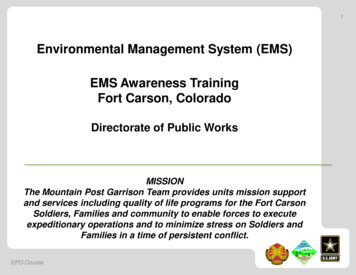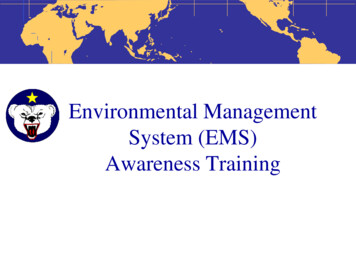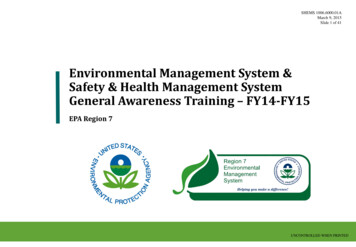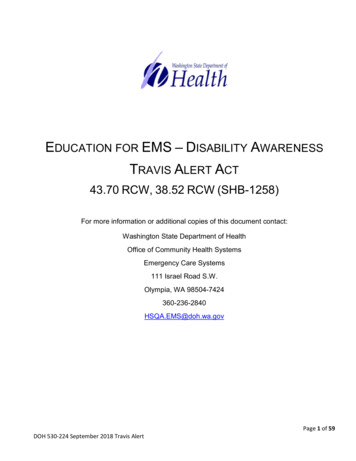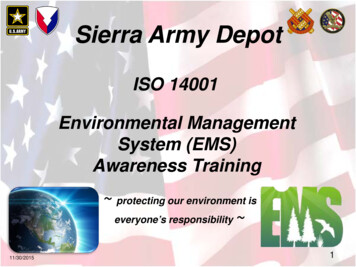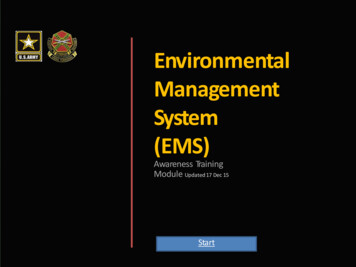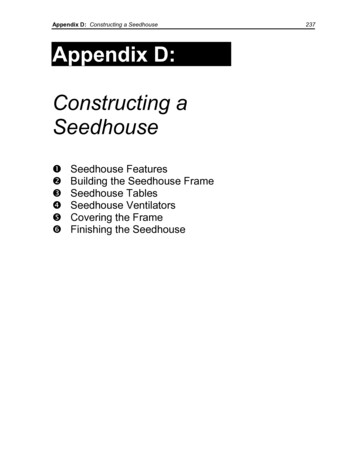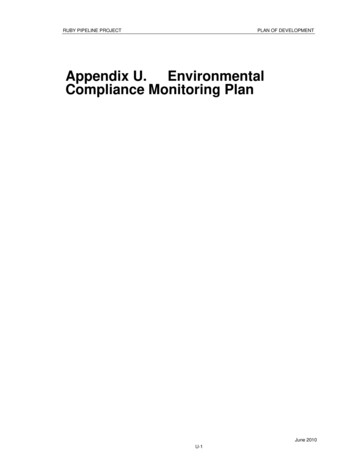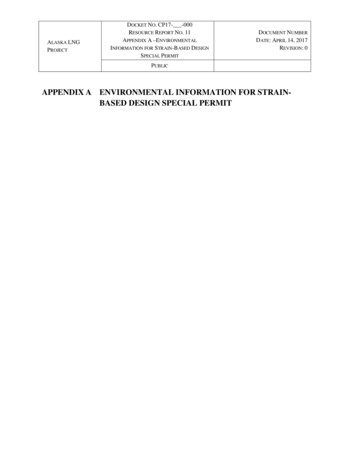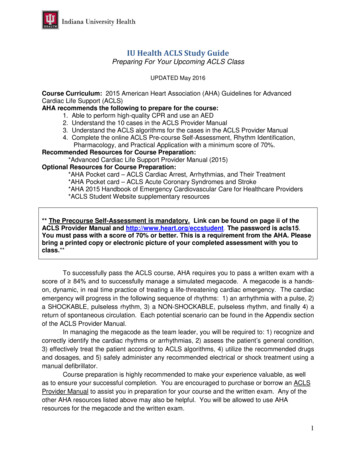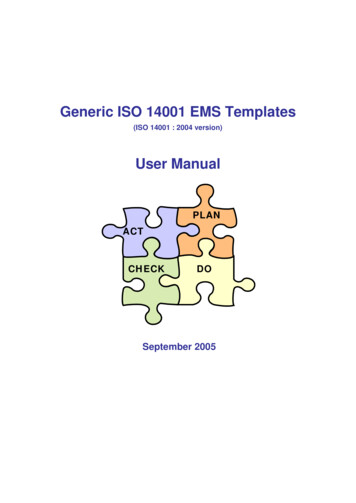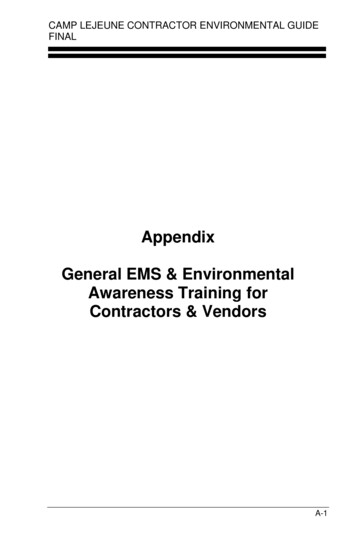
Transcription
CAMP LEJEUNE CONTRACTOR ENVIRONMENTAL GUIDEFINALAppendixGeneral EMS & EnvironmentalAwareness Training forContractors & VendorsA-1
CAMP LEJEUNE CONTRACTOR ENVIRONMENTAL GUIDEFINALPAGE INTENTIONALLY BLANKA-2
MCBCB Camp Lejeune, NNC/MCAS New RiverGeneral EMS andEnvironmental AwarenessTrainingforContractors and VendorsRevised: April 2008
Disclaimer This training does not replace any requiredregulatory environmental training as peryour contract Required environmental training should becompleted prior to working aboard the Installation Training records should be available for reviewupon request
Training Overview EMS and the Environmental Policy Environmental Management Division General Environmental Awareness Spill Response Basics Summary
EMS and theEnvironmentalPolicy
What is an EMS? MCB Camp Lejeune and MCAS New River have implementedan Environmental Management System (EMS) that is foundedon the principles of our respective Environmental Policy. The purpose of the EMS is to sustain and enhance missionreadiness and access to training areas through effective andefficient environmental management. The EMS emphasizes that the authority and principalresponsibility for controlling environmental impacts belong tothose commands, units, offices, and personnel, includingcontractors and vendors, whose activities have the potential toimpact the environment.
Why have an EMS?“To sustain our operations and trainingcapabilities, and to safeguard land-useavailability, . will comply withenvironmental laws and conserve the naturaland cultural resources with which it has beenentrusted.”Excerpt from the Commanding Officer’s Environmental Policy Statement
What YOU Need to Know The Installation has an EMS These three goals are the foundation of ourEnvironmental Policy:1. Comply with regulatory requirements2. Protect human health3. Conserve natural and cultural resources
YOUR EMS Responsibilities Be aware of the Environmental Policy Be familiar with spill procedures Keep your eyes open for potential problems Report any environmental problems or concernspromptly and notify your ROICC or ContractRepresentative
Environmental ManagementDivision (EMD), MCBCLEnvironmental AffairsDepartment(EAD), MCASNR
EMD/EAD can help! The appropriate environmental office works withyour ROICC or Contract Representative to ensure: Proper management of waste Compliance with regulations Required environmental plans are developed andfollowed, if applicable Required environmental training material is providedfor contractor use
What Does EMD/EAD Do for You? If you have EMS orenvironmentallyrelated questions,contact your ROICCor ContractRepresentative whowill then work withEMD & EAD todetermine how toproceed
Remember ALL environmental programrequirements are applicable toALL contractors and vendorsworking aboard the Installation!
General EnvironmentalAwareness
Water Quality Construction/demolition and other projects canresult in: Stormwater pollution Erosion and sedimentation If a project could impact water quality: Don’t dispose of oil, chemicals, or any othermaterial/debris down storm drains Keep sediment, leaves, and construction debris awayfrom storm drains (use barriers) Sediment Erosion Control Plans are required for siteswhen more than 1 acre will be disturbed
Used Oil Oil handling/changing operations can result in: Spills Waste Groundwater, stormwater, or soil contaminationi i If a project involves the use of oil: Perform maintenance in paved, designated areas Recycle used oil, oil filters, and other fluids don’tdump down storm drain or dispose of in the trash Clean up spills immediately and properly!
Air QualityIf a project could impact air quality: Prior to beginning operations, have yourROICC or Contract Representative contact theInstallation Air Quality Program representativefor applicable Federal and state permittingrequirements Follow all permit requirements, including material usagerecordkeeping for Title V permit sources Notify your ROICC or Contract Representative before bringing newequipment on site Notify your ROICC or Contract Representative before modifyingan existing permitted source (including physical changes andmaterial changes). Examples of permitted sources include boilers,generators, fuel tanks, and welding/soldering operations
Hazardous Waste Management Hazardous waste generation can result in: Consumption of natural resources Increased Regulatory Burden If a project generates hazardous waste: Reduce/Minimize the generation of hazardous waste Contact your ROICC or Contract Representative if unsure how tomanage a waste Don’t put hazardous wastes into general trash dumpsters Ensure satellite accumulation areas (SAA) are managed properly Notify your ROICC or Contract Representative prior to creating a new SAA! Ensure hazardous waste drums are labeled and lids are secured
Hazardous Materials If a project requires the use hazardousmaterial (HAZMAT): Keep flammable materials in HAZMAT lockers Don’t store large quantities – keep on hand only whatyou will use Maintain MSDSs for each material on-site Place materials stored outside in secondary containmentto prevent spill/reduce releases Stop work if you unearth a hazardous material (i.e.,ordnance) and report to your ROICC or ContractRepresentative
PCB and Asbestos If a project generates or involvesthe removal of PCB or asbestos: Manage and handle PCB andasbestos only if you are properlytrained Manage PCB and asbestos in propercontainers with appropriate labeling
Solid Waste Management Solid waste generation can result in: Consumption of natural resources Decreased landfill space If a project generates regulated or solid waste: Reduce/Reuse/Recycle when possible; meet contract requirementsfor recycling Contact your ROICC or Contract Representative if unsure how tomanage a waste Don’t put unauthorized wastes into general trash dumpsters –Recyclable products should be placed in appropriate containers ¬ co-mingled with solid waste Don’t use government-owned dumpsters for your contractor wasteand debris
Good Housekeeping Poor housekeeping canresult in: Fines, termination ofcontract Maintain good housekeeping: DO store flammable materials in HAZMATlockers DO ensure containers are labeled and lids aresecured Environmentalcontamination, spills DO keep stormwater drains clear of debris Injuries DO clean up work sites at the end of each day DO clean up spills immediately and properly DO clean up work area after job completion DON’T pour material down storm or floordrains DON’T stockpile waste – put it where itbelongs!
Spill Response Basics
If You Have or See a Spill Call 911
Natural Resources –Threatened & Endangered Species The Installation is currently home to nine federally listed endangeredspecies: red-cockaded woodpecker (RCW), green sea turtle, loggerheadsea turtle), rough-leaved loosestrife, seabeach amaranth, piping plover,American alligator, and American bald eagle and Hirst's panic grass. The following restrictions apply: Construction activities are restricted within1500 ft of a bald eagle’s nest Vehicles & lighting are prohibited on thebeaches overnight 1 May -31 Oct Cutting or damaging pine trees in notpermitted Fish & wildlife must not be disturbed
Natural Resources –Wetlands The US Army Corps of Engineers defines a wetland as" areas that are inundated or saturated by surface orgroundwater at a frequency and duration sufficient tosupport, and that under normal circumstances do support, aprevalence of vegetation typically adapted for life insaturated soil conditions." No discharge of fill material, mechanized land clearing, orany other activity is allowed in jurisdictional wetlands orWaters of the United States without the proper approvals. Permits will be required
Natural Resources –TimberThere are over 127,000 acres of forested land aboard theInstallation The MCBCL Forest Management Program has 1st right ofrefusal for all timber products on construction projects The following restrictions apply: Do not cut or deface trees w/o authorization Protect existing trees that are to remain inplace Do not fasten or attach ropes or cables toexisting nearby trees for anchorages w/oauthorization
Cultural ResourcesThe Installation manages a variety of historic andprehistoric archaeological sites, as well as historicstructures. IF YOU FIND A BONE, BOTTLE OR PIECE OF POTTERY THAT YOUTHINK MIGHT HAVE ARCHAELOGICAL OR HISTORIC INTEREST,DON’TDONT PICK IT UP. IF YOU FIND ANY OF THESE THINGS, MARKMAARK THETAREA & NOTIFY THE BASE ARCHAEOLOGIST, EMD AT 45151511-5063.
Summary
Summary MCB Camp Lejeune and MCAS New River protect,preserve, and enhance their natural resources throughtheir EMS and Environmental Policies We comply with relevant environmental laws and regulations We prevent pollution We continually improve the EMS YOU are responsible for complying with applicableenvironmental requirements too If you aren’t sure what to do ASK! Your ROICC or Contract Representative and EMD/EAD arehere to help
Remember Consult the Contractor Environmental Guide for moredetailed information pertaining to environmentalrequirements applicable to the work you do.If you have any questions or concerns about theinformation in this training, please consult with yourROICC or Contract Representative, who will contactthe appropriate environmental office if additionalclarification is necessary.
General EMS & Environmental Awareness Training for Contractors & Vendors . CAMP LEJEUNE CONTRACTOR ENVIRONMENTAL GUIDE FINAL A-2 PAGE INTENTIONALLY BLANK . MCB Camp Lejeune, NC/CB Camp Lejeune, N MCAS New River Revised: April 2008 General EMS and Environmental Awareness TrainingFile Size: 536KBPage Count: 32
